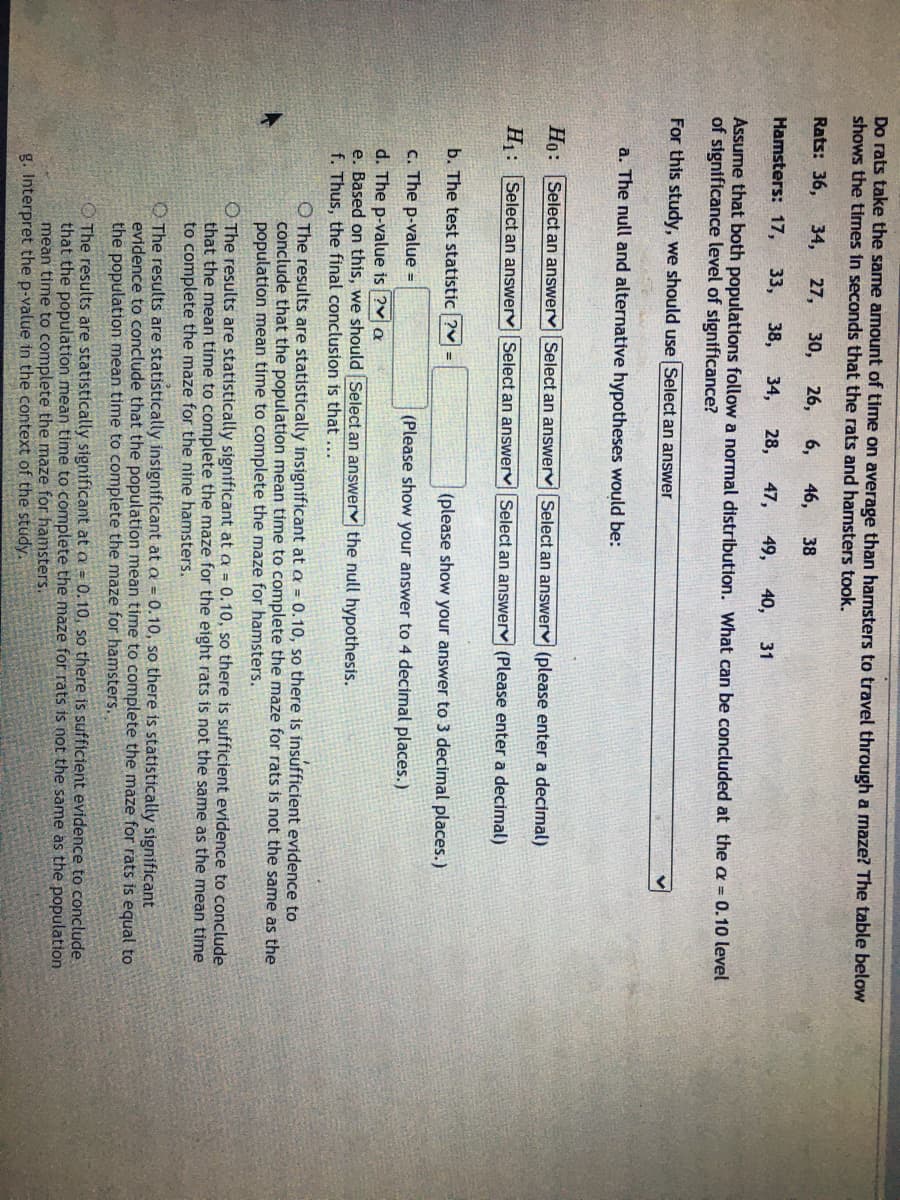Do rats take the same amount of time on average than hamsters to travel through a maze? The table below shows the times in seconds that the rats and hamsters took. Rats: 36, 34, 27, 30, 26, 6, 46, 38 Hamsters: 17, 33, 38, 34, 28, 47, 49, 40, 31 Assume that both populations follow a normal distribution. What can be concluded at the a = 0.10 level of significance level of significance? %3D For this study, we should use Select an answer
Do rats take the same amount of time on average than hamsters to travel through a maze? The table below shows the times in seconds that the rats and hamsters took. Rats: 36, 34, 27, 30, 26, 6, 46, 38 Hamsters: 17, 33, 38, 34, 28, 47, 49, 40, 31 Assume that both populations follow a normal distribution. What can be concluded at the a = 0.10 level of significance level of significance? %3D For this study, we should use Select an answer
Glencoe Algebra 1, Student Edition, 9780079039897, 0079039898, 2018
18th Edition
ISBN:9780079039897
Author:Carter
Publisher:Carter
Chapter10: Statistics
Section10.4: Distributions Of Data
Problem 19PFA
Related questions
Topic Video
Question

Transcribed Image Text:Do rats take the same amount of time on average than hamsters to travel through a maze? The table below
shows the times in seconds that the rats and hamsters took.
Rats: 36,
34,
27,
30,
26,
6,
46,
38
Hamsters: 17,
33,
38,
34,
28,
47,
49,
40,
31
Assume that both populations follow a normal distribution. What can be concluded at the a = 0.10 level
of significance level of significance?
For this study, we should use Select an answer
a. The null and alternative hypotheses would be:
Ho: Select an answervSelect an answerv Select an answerv (please enter a decimal)
H: Select an answerv Select an answerv Select an answerv (Please enter a decimal)
b. The test statistic ?v =
(please show your answer to 3 decimal places.)
c. The p-value =
(Please show your answer to 4 decimal places.)
d. The p-value is ?v a
e. Based on this, we should Select an answerv the null hypothesis.
f. Thus, the final conclusion is that ...
O The results are statistically insignificant at a = 0.10, so there is insufficient evidence to
conclude that the population mean time to complete the maze for rats is not the same as the
population mean time to complete the maze for hamsters.
O The results are statistically significant at a = 0.10, so there is sufficient evidence to conclude
that the mean time to complete the maze for the eight rats is not the same as the mean time
to complete the maze for the nine hamsters.
The results are statistically insignificant at Q = 0.10, so there is statistically significant
evidence to conclude that the population mean time to complete the maze for rats is equal to
the population mean time to complete the maze for hamsters.
The results are statistically significant at a = 0.10, so there is sufficient evidence to conclude
that the population mean time to complete the maze for rats is not the same as the population
mean time to complete the maze for hamsters.
g. Interpret the p-value in the context of the study.
Expert Solution
This question has been solved!
Explore an expertly crafted, step-by-step solution for a thorough understanding of key concepts.
Step by step
Solved in 2 steps with 1 images

Knowledge Booster
Learn more about
Need a deep-dive on the concept behind this application? Look no further. Learn more about this topic, statistics and related others by exploring similar questions and additional content below.Recommended textbooks for you

Glencoe Algebra 1, Student Edition, 9780079039897…
Algebra
ISBN:
9780079039897
Author:
Carter
Publisher:
McGraw Hill

Glencoe Algebra 1, Student Edition, 9780079039897…
Algebra
ISBN:
9780079039897
Author:
Carter
Publisher:
McGraw Hill